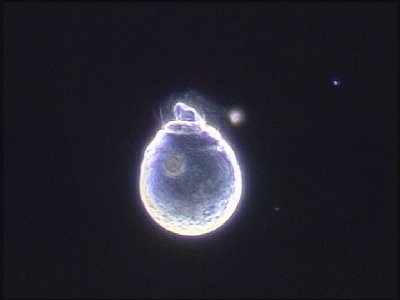



The Sea in the Seed
Sperm of Ginkgo biloba and Reproductive Evolution in Plants
A TokyoCinema Video, color 35min. completed
Japanese version January 2000 and English
version November 2000, All Rights Reserved
copyright: 2000, TokyoCinema Inc. all rights
reserved
Awarded:
41th Science and Technology Film and Video
Featival Tokyo, 2000
THE BEST RESEARCH FILM at 21th International
Biennial of Scientific Film Ronda, Spain
TEPIA GRAND PRIX
Video sales information:
Both in NTSC and PAL VHS or DVD-R in NTSC
copies are available for educational
purpose. For scientists who use for own research
and teaching purpose costs in US$250 and
audio-visual center where lends video copies
for sutudents and different teachrs, costs
US$500. We ship the video copy by Express
Mail Service (EMS) and shipping charges included
the price. You can preview English narration version in full length
FREE OF CHARGE, but sorry that you can not
copy the image.
The Sea in the Seed
02:00:14:
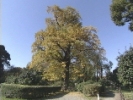
A little more than a century ago an important
botanical discovery was reported from Japan.
In 1896 Hirase Sakugoro discovered flagellated
sperm in a seed of Ginkgo biloba, then
Ikeno Seiichiro found the same phenomenon
in Cycas revoluta. Botanists around the world
were excited by these discoveries.
02:00:38:
In the higher plants, like most gymnosperms
and angiosperms, male gametes or non-flagellated
sperm cells are sent direct to egg cells
through pollen tubes. In lower plants, flagellate
sperm
cells to swim towards egg cells in water.
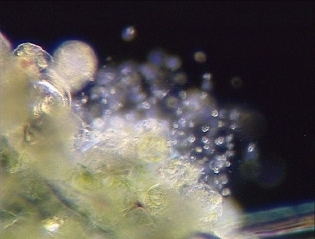
02:00:56
The discoveries made by Hirase and Ikeno
indicated that the Ginkgo and cycads are
intermediate
forms between higher and lower plants on
the evolutionary line. Among the seed plants
it is only
the Ginkgo and cycads which have been found
to have flagellated sperm cells in their
life-cycles.
02:01:27:
In the last few years, at the end of the
20th Century, has the detailed process of
fertilization of
these higher plants has been recorded successfully
in the living state.
02:01:58:
It is thought that all life originated in
the sea and that, later, certain organisms
adapted to life
on land. Land plants are all therefore considered
to have evolved from a species of green
fresh-water algae.
02:02:19:
The green alga Mesostigma, a flagellate,
is thought to be the closest relative to
the original
ancestors of land plants.
02:02:28:
The green body seen here is a chloroplast
where photosynthesis takes place.
02:02:38:
The red spot at the centre is the stigma
which is photosensitive.
02:02:49:
Two flagella are attached to a dimple in
the middle. The organism has no cell wall
and the outer
body is covered with scales, which is a common
feature in primitive green flagellates.
02:03:08:
Cell division of Mesostigma is shown here
using time-lapse videomicroscopy.
The central part of the organism furrows
before dividing into two. This primitive
process of
cytokinesis is found in many organisms, including
algae and all animal cells.
02:03:29:
This multicellular green alga, Coleochaete,
lives in fresh water when in the non free-living
state. Cell division enlarges its body size
but does not increase its population. For
this it produces
zoospores for non-sexual reproduction and
eggs and sperm for sexual reproduction.
02:03:47:
This transparent sphere is an antheridium
containing sperm cells. The large green part
at
the tip is the oogonium which contains egg
cells.
02:04:04:
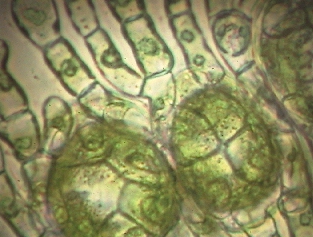
The fertilized egg in the oogonium is protected
by a covering of cells.
This protection is regarded as the first
evolutionary step which led ultimately to
life on land.
02:04:22:
This is a charophyte which is thought to
be the closest relative of the first plants
that made
the transition from the sea to the land.
It has a slender pineapple-shaped oogonium
and
a spherical antheridium. Only one egg is
held in the oogonium but the antheridium
carries many
sperm.
02:04:48:
Here antheridial filaments emerge from the
antheridium.
02:04:54:
These filaments are divided by cell walls
into many compartments, each of which contains
a sperm.
02:05:04:
When a sperm matures, it swims out into the
water.
02:05:14:
Sperm can be seen here swimming in slow motion.
In water a sperm can easily swim up to
an egg.
02:05:23:
If water is essential to the process of reproduction,
this raises the question of how the
first plants made the transition from water
to land.
02:05:35:
It has long been thought that the first plants
to make the transition from freshwater to
land
were the mosses and liverworts. This is the
liverwort Marchantia polymorpha. The part
of
the life-cycle which carries out sexual reproduction
is called the gametophyte. The organism
needs to live on a wet surface.
02:05:56
The structures which look like folded umbrellas
are female gametophytes or female receptacles.
02:06:02:
Many archegonia are found under the umbrellas.
02:06:08:
Fertilization takes place when a female receptacle
is short and the archegonium is covered
with water on the ground.
02:06:16:
This is a male gametophyte. The plate-like
male receptacle has many antheridia which
produce
sperms
02:06:27:
When one of these receptacles is covered
with water, sperms are released
to
swim in the film of water from the antheridium
to the archegonium to fertilise the egg.
02:06:42:
Here there is a white mass on the surface
of the male receptacle.
02:06:50:
It is a clump of sperm.
02:0:56:
Before long they will start to swim.
02:07:07:
Bryophyte sperm have two flagella. They swim
forward using the flagella at the anterior
end.
This is one of the characteristics of plant
sperms.
02:07:32:
After fertilization in the female receptacle,
the egg develops into a sporophyte to produce
spores. Meanwhile the stalk of the female
receptacle elevates and opens the umbrella.
02:07:48:
The yellow mass seen here is a lump of spores.
The spores are released into the air.
02:07:56:
The spores are attached to a slender thread-like
cell. When the thread shakes, the spores
spring off.
02:08:04:
As spores fly off and are carried far afield,
the range of mosses and liverworts or bryophytes
spreads and the population enlarges.
02:08:16:
Landing on wet ground, a spore immediately
germinates.
02:08:27:
Dark spots on the back of fern leaves are
masses of sporangia which contain many spores.
Ferns as well as bryophtes use spores to
increase their population.
02:08:40:
Ferns have a specialised organ called a vascular
bundle through which water and nutrients
absorbed from roots are transported to every
part of the organism. The presence of this
organ is the reason ferns are considered
to be higher on the evolutionary line than
bryophytes.
02:08:58:
The vascular system in ferns allows these
plants to grow as high as trees. The height
of the
foliage gives a greater chance for the spores
from these organisms to be carried further
to
extend the range of their habitats.
02:09:16:
Lygodium provides another example of fern
reproduction. This is asporophyte of Lygodium.
02:09:23:
Here many spores are packed in the sporangia
which are attached to the tips of the leaves.
When a spore emerges from the sporangium
and successfully lands on wet ground, it
germinates into a prothallium -a tiny gametophyte
where sexual reproduction takes place.
The gametophyte is extremely small.
02:09:47:
Many archegonia and antheridia are formed
on the surface of the gametophyte.
02:09:56:
These are archegonia.
02:10:00:
When an egg matures, the entrance of the
archegonium opens to receive the sperms.
02:10:07
These are antheridia producing large numbers
of sperm cells.
02:10:17:
When the antheridium touches water, the lid
opens and the sperms burstb out.
02:10:35:
The sperms can swim up to an archegonium,
but only if there is a thin layer of water
covering the gametophytes.
02:10:58:
In mosses or brophtes and ferns otherwise
knows as pteridophytes water essential for
sexual reprodeuction.
02:11:07:
However, the supply of water on land is irregular
- so how have the multitude of land
plants adapted to this environment?
02:11:16:
They have developed seeds!
02:11:19:
The Cycads and Ginkgo are now considered
to be the most primitive species among
existing seed plants. They have partially
followed the same method of reproduction
which the ancestors of green plants did in
the water but their solution has been to
produce a similar aqueous environment in
a seed.
02:11:38:
Ginkgo plants first appeared some two hundred
and eighty million years ago and
culminated in the Mesozoic era with the dinosaurs.
It is thought that dinosaurs fed
on ginkgo nuts like humans now. Ginkgo biloba
is therefore referred to as "a living
fossil", because the form of its leaves
and organs of reproduction are not much
different from those of the pre-historic
Ginkgos.
02:12:01:
The reproduction processes of Ginkgo biloba
retain the characteristics of lower land
plants.
02:12:13:
Ginkgo biloba is a dioeceous plant - meaning
that the male and female forms of the
tree exist separately.
02:12:23:
Close observation of growth confirms that
the Ginkgo's male flowers open several
days earlier than the female flowers.
02:12:31:
This time-lapse sequence shows the Ginkgo
beginning to bud.
02:12:53:
Here a structure which looks something like
a bunch of bananas develops in the axil
of the leaves.
02:13:00:
These are clusters of anthers which are generally
called male flowers .
02:13:29:
This is a Ginkgo male tree two weeks after
budding.
02:13:48:
The male flowers are growing.
02:13:56:
When the pollen is mature, anthers rupture
and pollen emerges.
02:14:23:
These small grains are Ginkgo pollen which
is carried to female trees by wind currents.
02:14:41:
This is an electron micrograph of Ginkgo
pollen. The pollen grain is four-celled.
One of
the cells produces sperms. A pollen grain
is therefore a "flying gametophyte",
though
its appearance resembles a spore.
02:15:00:
This is a female tree at the time when pollen
is released into the air by male plants.
00:15:07:
These small spherical structures seen among
leaves are often called female flowers,
but they are actually ovules. In early spring
the stalkes bearing ovules extend upwards
the sky.
02:15:20:
On the apex of a young ovule there is a pore
through which pollen enters.
02:15:26:
When it is ready for pollination a mucilaginous
droplet is exuded from the inside of
the ovule to catch the pollen.
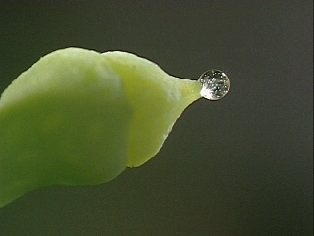
02:15:47:
Exudation and retraction of the droplet happens
repeatedly.
02:15:55:
Retraction of the pollination droplet brings
pollen grains into the pollen chamber.
02:16:04:
These are Ginkgo pollen grains.
02:16:20:
Pollen flows into the droplet.
02:16:47:
Fertilization does not occur immediately
after pollination because the egg is not
produced at this time. After pollen enters
the pollen chamber, differentiation of
the female gametophyte starts in the ovule.
02:17:13:
One month after pollination the young ovules,
or female flowers, are shed from
the tree when they can catch no pollen.
02:17:33:
The inner structure of a pollinated ovule
is shown here.
02:17:37:
This is a thin section through an ovule.
It shows one of the pollen grains inside.
A female gametophyte is in the process of
developing.
02:17:57:
Two and a half months after pollination the
stalks turn downwards and the ovules
are hanging off.
02:18:06:
The longitudinal median section of the ovule,
the large green portion at the centre,
shows two young archegonia in which eggs
will be produced.
02:18:18:
Usually only one of the two fertilised eggs
germinates the following year the other
egg degenerates and is eventually absorbed.
02:18:47:
Four months after pollination, pollinated
ovules have grown large on the female tree.
02:18:56:
Inside the archegonia egg cells are maturing.
02:19:07:
In the meantime a peculiar column of female
gametophyte tissue - known as the
"tent pole" - elevates between
two archegonia and extends towards the pollen
chamber to destroy the tissue between the
pollen chamber and the archegonia.
02:19:21:
The apex of the expanded pollen tube is shown
here. Both the pollen chamber and
the space around the tent pole have been
united to become a bigger archegonial
chamber. When the two sperm are produced
in the pollen tube, this large chamber
is filled with fluid. This fluid could be
regarded as "the sea" produced
in the seed.
02:19:43:
A central cell, which will later differentiate
into two sperms, can be seen inside
the stretched pollen tubes. At this stage
the archegonial chamber has not yet
filled with liquid."The sea" appears
in the archegonial chamber around the time
the sperms are released.
02:20:00:
This sequence shows how sperm cells are differentiated
from the central cell,
shown here.
02:20:06:
The long portion at the centre is a nucleus.
02:20:09:
The large globules in the upper and lower
parts are lipid bodies.
02:20:15:
On the outer part there are small globules
called blepharoplasts which are clusters
of sperm cilial bases.
02:20:23:
Two doughnut-like nucleoli are found in the
nucleus.
02:20:27:
At the apex of the pollen tube are the first
and second prothallial cells and a stalk
cell.
02:20:38:
When the central cell becomes elliptical
and wide than the stalk cell, cell division
begins to produce sperm.
02:20:49:
Chromosomes appear inside the nucleus.
02:20:57:
Here nuclear division has finished and the
mother nucleus has divided into two.
Cytoplasmic granules begin to accumulate
along the furrow and this l eads to
cytoplasmic
cleavage, cytokinesis.
02:21:16:
Division of the central cell can now be seen.
02:21:20:
Look carefully at the line which just appeared.
An inwardly invaginated furrow developed
and the cell divided into two. Ginkgo biloba
uses the same primitive method of cytoplasmic
division for reproductive cell division which
is found in Mesostigma.
02:21:42:
Two divided cells can be clearly seen here
in longitudinal section. The lines in the
middle
are the cell membranes of each cell.
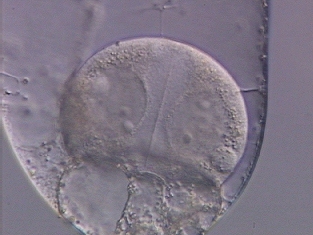
02:21:54:
As cytokinesis is completed, a great number
of cilia develop on the spiral band from
the
blepharoplast.
02:22:20
In this repeat of the process, watch the
cell of left . It shows clearly how the cilial
spiral
develops.
02:22:44:
As if twisted off, the central cell has just
divided into two sperm cells.
02:23:09
Now two sperms are produced.
In the spring. pollen grains - or male gametophytes
- are carried by wind currents to ovules
- or female gametophytes. The pollen grains
are caught and pulled into the pollen chamber
by retraction of pollination droplets.
02:23:26:
During the five months following pollination,
the pollen grows big enough to form two sperms,
absorbing water and fertilizer from the female
tissue - a nucellus. The eggs mature at the
same time.
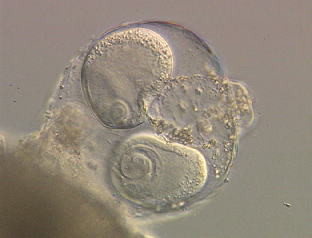
02:23:39:
As the sperms get ready to swim, the female
gametophyte prepares "the mother sea"
in the
archegonial chamber.
02:23:48:
The precise timing of this process is one
of the miracles of nature.

02:23:52:
The pollen tube ruptures and the sperms swim
in "the sea" toward the eggs. As
we have
already seen, Ginkgo sperms swim forward
with cilia at the front just like the charophytes,
bryophytes and pteridophytes.
02:24:09:
The cilia are arranged in a spiral.
02:24:16:
Here, in an electron micrograph, can be seen
the fine structure of the cilial bases.
02:24:23:
The basal bodies of the cilia are aligned
in parallel and are attached to a complex
multilayered
structure.
02:24:33:
This multilayered structure of the cilial
apparatus is characteristic of sperm and
swimming
cells of organisms in the evolutionary line
to land plants.
02:24:45:
Those algae which have no link with land
plants, such as Chlamydomonas, do not have
a
multilayered structure.
02:24:56:
During fertilization, Ginkgo biloba excretes
reproductive liquid from its own tissue to
create
"the sea" in the seed. Compared
to mosses and ferns, Ginkgo sperm can swim
safely in
"this inner sea" and can reach
the egg cells more successfully.
02:25:22:
The egg cells attract nearby sperms to the
entrance of the archegonium. Fertilization
occurs
about four months after pollination, between
the end of August and the beginning of September.
02:25:39:
This is the ovule of Cycas revoluta at the
time of fertilization. Fertilization of the
cycad resembles
that of Ginkgo biloba. In October sperms
are produced in the pollen tube.
02:25:53:
These are mature cycad sperms.
02:26:01:
The sperms have just been released from the
pollen tube.
02:26:13:
The sperm of cycads may be the largest in
the plant world. They have tens of thousands
of cilia.
02:26:24:
They also swim in "the sea" toward
the egg cells.
02:26:38:
Here a sperm enters the archegonium. The
dark part at the centre is the entrance of
the
archegonium which holds the egg cells. The
sperm swims around the entrance, sensing
the attracting
chemicals which are probably released by
the egg.
02:26:57:
The sperm now enters the archegonium. It
takes about twenty seconds for a healthy
sperm to pass
through and it has to elongate its shape
to get through the extremely narrow entrance.
After entering
the archegonium, the sperm recovers its shape.
02:27:23:
It has just entered. Fertilization and fusion
of the sperm and the egg cell then follow.
02:27:35:
Conifers are gymnosperms just like Ginkgo
and the cycads, but they do not produce ciliated
sperms.
02:27:43:
They extend pollen tubes in the ovule and
send their non-ciliate sperm cells directly
to the egg cells
like most other advanced angiosperms.
02:27:55:
Here are some examples of male pine flowers.
They release pollen which is carried by wind
currents to
female flowers.
02:28:03:
This is a female pine cone.
02:28:08:
The pines need about three years from the
development of reproductive organs to the
maturation of
seeds.
02:28:17:
Angiosperms are more advanced than conifers.
02:28:21:
The pollen of angiosperms is carried not
only by wind currents but also by birds and
insects.
02:29:07:
This is Torenia fournieri which shows the
double fertilization characteristic of angiosperms.
02:29:15:
At the centre is a pistil and the upper and
lower parts are stamens.
02:29:21:
The moment pollen grains attach to the tip
of the stigma, it encloses them.
02:29:28:
Here pollen adheres to the stigma. Pollen
tubes extend, absorbing fluid produced from
the pistil.
02:29:58:
The pollen tubes grow downwards in the style
towards eggs in the embryosac.
02:30:03:
Here is a section of a style showing many
extending pollen tubes.
02:30:30:
Each is a long slender cell containing cytoplasm
which is actively streaming. The fluid
environment inside the pollen tube and the
style is kept stable. It resembles a pipe
full of
water.
02:30:50:
Here, under a fluorescence microscope, two
nuclei can be seen inside the pollen tube.
They are pollen tubal and generative nuclei.
At the bottom of the picture they are moving
towards the anterior end of the pollen tube.
A generative cell will divide into two sperm
cells.
Now the cell division starts. Immediately
after nuclear division, cytokinesis produces
two
sperm cells. The sperm cells of angiosperms
have no flagella or cilia because they do
not
swim, though they play the same role as sperms.
02:31:30:
The protoplasmic streaming and the movement
of the nuclei in the pollen tube seems not
to be random but more of a planned migration
targetting the eggs.
02:31:49:
Torenia's embryo sac,is seen here protruding
from the micropyle. This allows us to look
at
the interior and to analyse the fertilization
process in detail.In here a part of the embryo
sac,
an egg,two synergids and half of the central
cell are outside the micropyle.
02:32:06:
Synergids attract the approaching pollen
tube to the embryo sac with chemicals. Sperm
cells move towards the apex of the pollen
tube.
02:32:20:
In Torenia a pollen tube will reach an embryo
sac approximately nine hours after pollination.
In Cycas revoluta and Ginkgo biloba the time
between pollination and fertilization is
three
to four months, and in pines - about three
years. Compared to gymnosperms, angiosperms
take a shorter time for fertilization. This
results in a higher success rate in fertilization.
02:32:44:
Here the apex of a pollen tube is firmly
inserted in the centre of an embryosac. The
pollen
tube bursts open and protoplasm rushes in.
Carried along in this flow, two sperm cells
also
enter the sac. One of the sperm cells fuses
with the egg and the other with the central
cell.
This type of fertilization is called "double
fertilization"-characteristic of angiosperms.
Double
fertilization was first reported almost simultaneously
with the discovery of Ginkgo sperm.
A hundred years later the entire process
of the double fertilization was video recorded
for
the first time. Mosses and ferns discharge
sperms into water externally and fertilization
takes place there. Cycads and Ginkgo produce
a "sea" inside the seeds where
the sperm swim
and fertilize. Angiosperms, on the other
hand, send sperm cells direct to eggs through
extended pollen tubes. The process of reproduction
is impressive to watch in any organism
because it is the key to life itself.
02:33:55:
Plant reproduction processes are directly
related to plant evolution. The green organisms
on earth are proof of this and the history
of the evolution is carried in this seeds.
02:34:17
Reproduction process in this plant provides
a unique key to our understanding of the
evolution
of higher plants.
02:34:18:
The budding of the further evolution begins
with the budding of this tree.
The end.
contacts:Å@info@TokyoCinema.net
TokyoCinema Inc.,
#302, 7 Ichigaya-Tamachi-2,
Tokyo 162-0843 JAPAN
phn:+813-3269-6751 fax: +813-3269-6746
![]() wallpaper courtecy of Kiyohdoh
wallpaper courtecy of Kiyohdoh